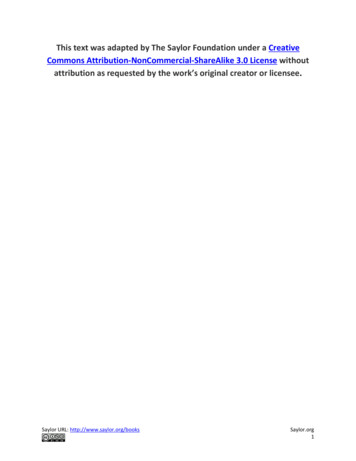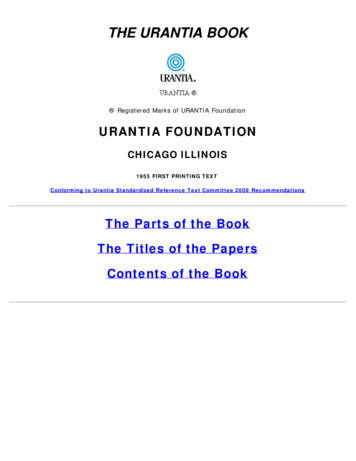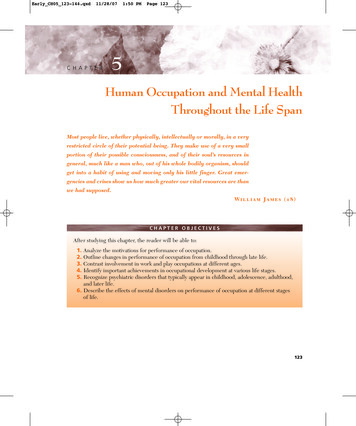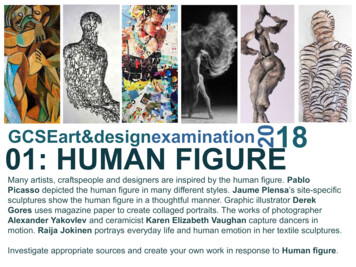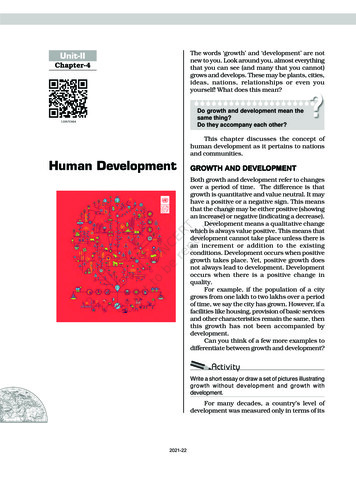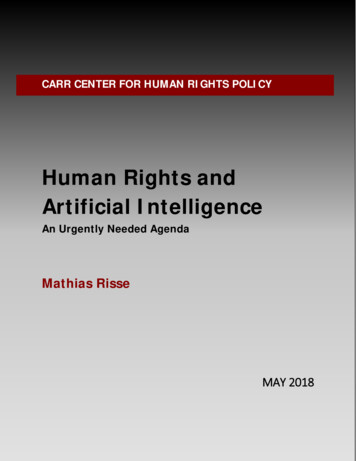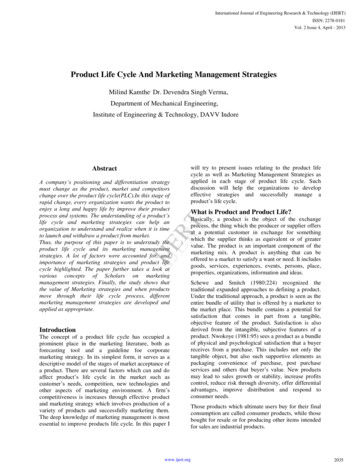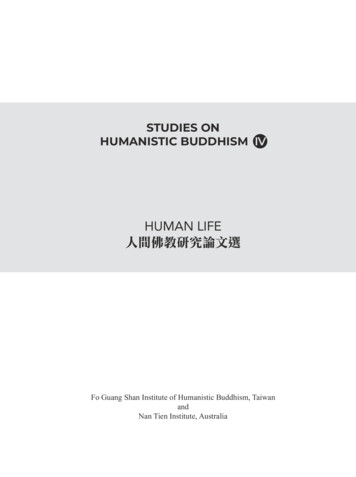
Transcription
STUDIES ONHUMANISTIC BUDDHISM IVHUMAN LIFE人間佛教研究論文選Fo Guang Shan Institute of Humanistic Buddhism, TaiwanandNan Tien Institute, Australia
PERSPECTIVE:THE TEACHER AND LATE MODERNBUDDHISM IN THE WEST:COMMITMENT AND DILEMMASNadine LevyLecturer and Head of Health & Social Wellbeing,Nan Tien InstituteandSuzanne FranzwayEmeritus Professor, Sociology and Gender Studies,University of South AustraliaSourceNadine Levy and Suzanne Franzway, “Perspective: The Teacher and Late Modern Buddhism in theWest: Commitment and Dilemmas,” Studies on Humanistic Buddhism, no. 4 (September 2021):157-165, https://journal.nantien.edu.au.
The teacher plays a key role in Buddhism. In some traditions, thepractitioner is advised to remain patient and persistent in the search for a lifelong teacher, as the right teacher is said to appear only once the practitioner is“ready.” The teacher may be the abbot in a monastery, the geshe in a gompa,or the roshi or ajahn in a temple. However, in this late-modern world, it isbecoming increasingly common for Convert Buddhists to have no link orpersonal connection to any such organization or individual Dharma teacher.This raises countless associated questions. For example, is practicingwithout connections to a teacher or indeed, any Buddhist organization,skillful? And if not, where does one find a Dharma teacher, particularly duringa global pandemic? Does one still need to travel to a faraway land to find aguru, or has this Western practice lost its currency? Is it preferable to have a‘personal’ relationship with the teacher or is it enough to simply read theirbooks, listen to their talks, and/or connect over the internet? Further, whena practitioner finds a teacher, must they commit for life? Or only until theyfeel they have learned what they need? And what are the parameters of such arelationship, how are they set, and by whom? These questions have begun tobe taken up by a range of teachers and scholars,1,2 particularly in response tothe many troubling revelations that have emerged regarding sexual abuse andthe misuse of power in the teacher/student dynamic.Historically, Buddhism has developed across multiple traditions, whichhave flourished, declined, and transitioned across different cultures, modifyingpractices and shifting focus according to the cultural, societal, and spiritualneeds of the milieu in which it has interacted. Yet each iteration has retainedBuddhism’s claim to the “spiritual” aspects of the religion which originatedover two thousand five hundred years ago in India with Siddhārtha Gautama/Śākyamuni Buddha, the first teacher of Buddhism.In the last one hundred and fifty years, Buddhism has begun to appearoutside Asia, during the time when European empire builders and colonizerswere busily imposing their political, economic, and religious systems onAsian societies. They were unwittingly creating bidirectional pathways for156
the transmission of cultures, philosophies, and social practices. For example,Japanese art had an enormous impact on European creativity at the turn ofthe twentieth century. Buddhist texts and practices were carried by Europeantravelers, including several women of note. In 1880, Helena Blavatsky(famous for founding Theosophy) became the first European to declareherself a Buddhist, while Alexandra David Neel spent many years studyingand practicing Buddhism in Tibet and other Asian countries, as well as writingbooks on Buddhism for European audiences. The British scholar I.B. Hornerspent some years in India, before becoming one of the key translators of Pālitexts for English readers.Following the upheavals of global wars and decolonization, Buddhistteachers, usually ordained Asian monks, began to join these travelers inbringing the Dharma into the West. Notably, the first teacher to visit Australiawas a woman Buddhist—Sister Dhammadinnā, who arrived in 1952. For abrief moment in the 1960s and 1970s, it became possible for young Westernersto travel with relative ease to meet and train with Buddhist teachers on theirhome ground. Some became ordained and were therefore granted licence toteach the Dharma themselves. The process of transmission began as they andtheir Asian teachers established Dharma centers in the West. This meant thatstudents and teachers needed to find ways to access each other’s language.So, in this sense, the encounter between Buddhism and the West alsobecame an encounter of languages. Not only between the multiple languagesof contemporary Asian Buddhism and Western practitioners, but also thelanguages of the foundational Dharma texts, namely Pāli and Sanskrit. Thus,translators also played key roles in Convert Buddhism, even if they have satin the shadow of the teacher’s throne.In this article, we offer our personal reflections on our own searchfor a “teacher” and “tradition” within the Western world, with the hope ofcontributing to and expanding this discussion to include more diverse voices.We are both white, cisgender female, feminist academics from working-classbackgrounds, and we have both identified as Buddhists for over two decades.157
We have been pondering our experiences through many conversations overalmost as many years. Like many other Convert Buddhists, we have increasingopportunities to engage with the many forms, techniques, and approacheswhich are being generated from close connections to the traditions of Buddhismpractised in Asian societies. In recent decades, these changes have begun toproduce versions of Buddhist practice which warrant new designations suchas Western Buddhism, Modernist Buddhism, and even Secular Buddhism.Suzanne spent her early years as a Convert Buddhist being taught a formof meditation by lay students in a Tibetan Buddhist gompa. She listened to aTibetan geshe’s teachings via a translator, a woman who was highly valuedby students for her skill in making the Dharma texts, including the teacher’scommentaries, very clear. In contrast, the subsequent translators at the gompawere much less committed to dialogue between the geshe and the students,as they seemed intent on maintaining the language barriers and hence theknowledge barriers between the geshe and their students. Fortunately, thepublications of work by other translators and teachers in the English languagegave Suzanne a form of democratic access to Buddhist teachings andcommentaries. Books, papers, whole journals, and even the occasional filmbecame available, although for English speakers these were largely dominatedby writers in the US and the UK. The internet also allowed recordings ofteachers to be heard and seen everywhere with the result that one was nolonger dependent on a single teacher or a local Saṅgha.Nadine began her journey also practicing Tibetan Buddhism, althoughmany of her initial teachers were native English speakers. She recalls suchWestern teachers emphasizing the idea that finding a qualified and reliableguru was essential to awakening. Such a guide, they explained, could usethe sword of wisdom and “clear seeing” to cut through the ways in whichwe delude ourselves and shed light on the ways that we misinterpret andmisapply the Dharma. Without commitment to a teacher, it was reiterated,students were missing out on the potential for spiritual maturation that comesfrom working through the more complicated and interpersonal aspects of thepath that invariably arise in a long-term relationship with a guide.158
However, as feminists trained in critical thinking, we both found thenotion of long-term commitment to one particular teacher within one particulartradition problematic, not necessarily out of the question, but problematic.There were several reasons for this.First, we noticed a hierarchical teaching approach in the centers wefrequented. Suzanne spent many years with the Gelug wing of the Mahāyānatradition, mostly at the one gompa with the final few years at a second butrelated gompa. Much of her experience hinged on going to regular weeklyteachings or courses taught by the resident geshe, usually shaped by workingthrough a text and the connected commentaries. The method was traditionaland structured, questions were not encouraged and accorded little time.For Suzanne, there was something calming about this experience,especially in the early years when sparks of insight would flash out fromthe teacher’s words. In terms of the Dharma, she felt the value of payingattention to body and mind growing slowly throughout these years. However,the interest and the curiosity of the experience of sitting within a Saṅgha at thefeet of a teacher began to diminish as the Saṅgha’s subservience to the geshebecame more overt and apparent. She noticed a general refusal to engagein contemporary philosophical debates on language and truth, with classicalmetaphors and simplified understandings of everyday life accepted as reality.Thus, an early problem for Suzanne emerged with her growing antipathytoward the rigid interpretations of the Dharma and simplistic representationsof modernist Western society in the teachings. She recalls statements like,“Westerners are all obsessed with consumerism (especially cars),” amongothers, that offered little to engage or enhance her understanding of the Dharmaand consider its applicability to the complexity of her life as a woman.Her impatience was sharpened with the discovery of the work of layteachers such as Martine and Stephen Batchelor, and some of the InsightMeditation Society teachers, especially Joseph Goldstein, Sylvia Boorstein,and Jack Kornfield. Their teachings offered practices and interpretations thatwere contextualized by their representations of the social history of Asian andWestern Buddhism, by their attention to the body, and to the nurturing of heart159
and mind. Suzanne began to broaden and, she hoped, deepen her Dharmapractice through her reading of contemporary Dharma texts, especially thosecreating so-called secular interpretations. Although wary of the risks of dilutionof the Dharma, she found that these texts opened creative and evocativepossibilities for appropriate and inspiring ways to practice. The opportunity totake silent retreats with Insight Meditation groups, framed by secular Dharmateachings, gave her a taste of the power and value of concentrated practice.Retreats also highlighted the importance, but also the unpredictability, of theimpact of the teacher.From early on in her path, Nadine experimented with multiple traditions.She remembers sitting straight-backed in the zendo, prostrating to the feet ofthe Tibetan lamas, circumambulating stupas, talking crazy wisdom with theShambhala community, and mindfully walking in the park with Thich NhatHanh’s Order of Interbeing. Like Suzanne, she also became deeply engagedby the works of Jack Kornfield, Joseph Goldstein, and Sylvia Boorstein3 andbegan a daily Insight Meditation practice—an approach she felt mirrored andresonated with her experiences within the Western cultural milieu. Duringthis time, she recalls asking repeated questions to a variety of teachers aboutthe relationship between the traditions and at times being dismissed, often bymale teachers, for “mixing up” and “confusing” traditions. Were the teacherssimply out of their depth? Or was she being dismissed on the basis of her ageand sex?Nadine felt that the notion of commitment to a singular path and teacherdid not reflect the fact that as she changed, her spiritual needs changed.Initially, as a woman in her early twenties, many of her needs were what onemight call “psychological” in that they were largely linked to her formativeexperiences growing up, but as time went on, she became more concernedwith collective, relational, and existential matters (though, of course, thesedomains cannot be fully separated). She began to feel it was not skillful toremain committed to a teacher out of obligation, but rather to continue onlywhile they met her where she stood and linked her to her own capacity forlove and awareness as she grew and changed.160
Early in her Dharma journey, Nadine was troubled by the idea that whenthings got too difficult, she would flee. And at one point, she did flee. Havingsat regularly for several years with a male Zen teacher, she began to deepenin her practice and feel overwhelmed by a type of precognitive anguish, notlinked with any particular words or images. Without adequate language toexplain her experience, as well as the intuitive sense that discussing suchemotions fell outside the discursive parameters of the Saṅgha, her experiencefelt almost unspeakable. Slightly out of conscious view, she reasoned that thebest course of action was to stop the practice and leave the Saṅgha altogether,which she did.This type of experience is not rare. Some suggest that long periods ofpractice can lead to the relaxing of bodily and psychological defenses and thatunresolved grief and afflictions can come into full view. However, as Nadinediscovered, relying on the support and expertise of one single teacher in caseslike this poses potential risks. Such teachers may not have the resources and/or language to support their students or the capacity to recognize the need todraw on external support structures. Moreover, Nadine found that her sufferingwas culturally specific, linked to both her gender and class background, aswell as Western understandings of emotions—something which she intuitedlay beyond her teacher’s experience.Simultaneously, the more we talked together, the more we both becameconcerned about the patriarchal assumptions that circulated through themeditation halls in which we sat, particularly the scarcely critiqued notionthat being born a woman was a major hindrance to enlightenment. This wasthe early 2000s. A more complex, but equally common, version of the issue ofgender and the Dharma was reported by Judith Simmer-Brown:How can you say women can’t get enlightened? He[her teacher] just stared at me and pointed his fingerand he said, “So you’re a woman?” In other words, Ihad grasped the man-woman concept. He was sayingthat you can’t attain enlightenment if you hold on to161
that self identity. I really liked that approach.4The stumbling block for us was (and still is), that if gender identity isirrelevant, or a failure of the mind to let go of dualism, how is it that Dharmateachers in every tradition are almost exclusively male? Why are senior nunsexpected to bow to even the most junior monk in some traditions? Suchuncritical and discriminatory assumptions led us both to a sense of disconnectfrom the value of the teachings (and the teacher) that felt almost impossibleto overcome.We were also both troubled by an apparent lack of fresh or criticalviews we observed in certain Buddhist communities. We noticed many of thetraditions we practiced with included ideological and/or doctrinally drivenpractitioners that did not demonstrate an openness or spirit of inquiry, whichwe both believe is a fundamental aspect of Buddhism. In fact, this is somethingrepeatedly emphasized by His Holiness the Dalai Lama: critical inquiry formsthe bedrock of Buddhist practice.5In talking over our experiences and questions with each other, wegradually came to feel compelled to develop a broad understanding of multipletraditions and to compare different approaches and techniques with the aim ofassessing which aspects were most applicable to our lives as we navigated ourown suffering—much of which was culturally-specific and gendered.Despite the notion of devotion to one tradition or teacher, we developedour own form of commitment, which we can only name with the gift ofhindsight: a commitment to deep investigation, critical thinking, and tosituating each tradition, and its contemporary manifestation, within the contextof the cultural milieu in which it appeared and arose from. This is a hugetask for lay-people, and is still very much a work in progress. Despite bothfeeling somewhat concerned about “shopping around” it was a commitmentto learning, investigating, and situating knowledge within its socio-historicalcontext that led us both to interrogate, compare, and practice with differentSaṅghas and teachers.162
Nadine now sees that having a sense of the varying traditions and a tasteof the range of teachers within Buddhism gave her greater capacity to makesense of her specific flavor of dukkha and to stay with its unfolding. Withtime and a combination of practices and teachers, she feels better able topay particular attention to its shape, texture, and rhythm in her experience.The archetypal qualities of Avalokiteśvara provided a safe psychologicalrefuge and a soft place to land when the small self alone could not carrythe load. Tibetan Buddhism also encouraged her to work with the notion ofgreat compassion that challenged the thought, “Why me!” The Zen traditionbrought her closer to a sense of the ground she sat on and the bones that saton it, as well as intimacy with the exquisite orchestra of sensations (someof which are unpleasant) that animate this very body. It was teachers fromthe Theravāda tradition who were her companions through periods of seriousdoubt, reminding her that liberation was very possible and that there is a clearmap showing the way out of suffering.We have now come to the point of committing to a paradigm of ConvertBuddhism which encompasses a plurality of teachers and traditions as they areexpressed in the West. Nadine finds herself in the Insight Meditation tradition,regularly engaging with the teachings of Jack Kornfield, who embracesmultiple modalities and approaches. In addition, the Insight Meditationtradition, particularly Spirit Rock Meditation Center, is influenced by theWestern psychotherapeutic paradigm6 and, as such, treats the mechanics andparticularities of one’s psychological suffering in a way that is familiar anduseful to Westerners. Through this paradigm, Nadine was able to recognizeand apply the conceptualizations of emotions that teachers use in this tradition,as they resonated with her own cultural conditioning.7 For Suzanne, emergentsecular versions of the Dharma have captivated her for a number of yearsnow. This paradigm allows her to read a variety of texts across traditions,enroll in short courses, listen to different teachers, and even participate insmall discussion groups and short retreats without identifying with any oneteacher.163
Nevertheless, looking for answers to specific psychological concernsthrough experimenting with multiple Buddhist groups had a certainintelligence underpinning it. For Nadine, the decision to knock on the door ofthe FPMT center (Foundation for the Preservation of the Mahāyāna Tradition)at the impressionable age of fourteen, the courage to stay silent for hours ata time and ask “what is this?” and the attempt to attain concentrated states ofmind to quell dukkha were all wise and understandable responses for a mindthat aches. However, we now see that no one teacher can “fix” our unique andculturally specific problems, whatever their universal spiritual means.For us, the question has become not “Who is your teacher?” but “Doesthis teacher’s tradition or technique bring you closer to your true nature?”This is the question at hand, whether it is the nature of awareness of rain dropsoutside the window, or the nature of the body/mind/heart in this moment. Thisis echoed clearly in the words of Fleischman:An important feature of the Dhamma, as the Buddhaunveils it, is its empirical nature. The Dhamma isnot the Buddha’s belief or viewpoint or religion orphilosophy. The Dhamma was discovered by theBuddha in the same way that gravity was discoveredby Newton or natural selection was discovered byDarwin. The Dhamma exists, and those who discoveror rediscover and expound it, within the humancommunity, are known as Buddha.8We now have the privilege of being able to access many teachers andtraditions with relative ease. But we also have the responsibility of navigatingthe Dharma and Saṅghas with as much skill and mindfulness as we can. Therisk is that of becoming a dilettante with only shallow understanding, andwith fragile practice, unsupported by the strength of a tangible communityand knowledgeable guidance. We hope that we can see the difference betweenrunning for the hills and simply yearning for another interpretation or criticalresponse to this beautiful pursuit in which we are engaged. As the Buddha164
said, “Things fall apart. Tread the path with care.” For now, we have what theBuddha recommended: strong Dharma friendship. Perhaps this is our teacher.Notes1 A. Gleig, “Sexual Violations in American Buddhism: Interpretative Frameworks and GenerativeResponses,” accessed March 5, 2020, ve-responses/.2 L. R. Owens, “Healing from Teacher to Student Ethical Misconduct,” filmed 2017, https://www.bhumisparsha.org/videos. Viewed 29 January 2021.3 It is interesting to look back and realize that most of these teachers aside from one or two did notshare Nadine’s gender. Most of the “custodians” of the Buddhist traditions we both encounteredin the late 1990s and early 2000s were men, yet it was rarely discussed explicitly. We note thisbecause of the way discourses of emotions and the body are gendered and expressed differentlydepending on gender identification.4 J. Simmer-Brown, “The Roar of the Lioness Women’s Dharma in the West,” in C. S. Prebish & M.Baumann ed., Westward Dharma (Berkeley: University of California Press, 2002), 317.5 His Holiness the Dalai Lama, “Critical Thinking and Inquiry are the Bedrocks of BuddhistPractice,” accessed April 15, 2021, he-dalai-lama-concludes-dharma-discourse/6 S. R. Segall ed., Encountering Buddhism: Western Psychology and Buddhist Teaching, (NewYork: SUNY Press, 2012).7 “Therapy culture” has gained a lot of momentum in the US and has a strong presence in Australiaas well. For an illuminating discussion on the opportunities and limitations of the culture oftherapy and self-help, see E. Illouz, Saving the Modern Soul: Therapy, Emotions, and the Cultureof Self-Help (Berkeley: University of California Press, 2008).8 P. Fleischman, “The Buddha Did Not Teach Buddhism,” Insight Journal 25 (2005): 7-11.165
BACK ISSUESStudies on Humanistic Buddhism I:Foundational ThoughtsMaster Taixu 太虛大師(Founder, Association for the Advancement of Buddhism)How to Establish a Humanistic BuddhismVenerable Tzu Hang 慈航法師(Founder, Chinese Buddhist Studies Association, Burma)Establishing a Humanistic Pure LandZhao Puchu 趙樸初(Former President, Buddhist Association of China)The Relationship Between Buddhism and Chinese CultureVenerable Master Hsing Yun 星雲大師(Founder, Fo Guang Shan)Fundamental Tenets of Humanistic BuddhismVenerable Master Hsing Yun 星雲大師(Founder, Fo Guang Shan)My Understanding of Humanistic BuddhismLi Li’an 李利安(Professor, Northwest University)The Harmonious Development Between Humanistic and TraditionalBuddhism and its IssuesCharles H.C. Kao 高希均(Founder, Global Views—Commonwealth Publishing Group)Can “Venerable Master Hsing Yun’s Values” Increase Social Harmony?Chen Bing 陳兵(Professor, Sichuan University)Venerable Master Hsing Yun’s Humanistic Buddhism: New Dawn of TrueDharmaCheng Gongrang 程恭讓(Professor, Shanghai University)Venerable Master Hsing Yun’s Ten Great Contributions to Buddhism
Cheng Gongrang 程恭讓(Professor, Shanghai University)Recent Conclusions on the Theory of Humanistic Buddhism: Lookingat Venerable Master Hsing Yun from Hear Me Out: Messages from aHumble MonkDong Ping 董平(Professor, Zhejiang University)The Historic Position of Humanistic Buddhism from the Viewpoint of theProcess of Sinicization of BuddhismGuang Xing 廣興(Associate Professor, University of Hong Kong)The Buddha in Humanistic BuddhismLai Yonghai 賴永海(Professor, Chinese Culture Institute, Nanjing University)Humanistic Buddhism and the Modernization of BuddhismKan Cheng-tsung 闞正宗(Associate, Fo Guang University)The Process of Modernizing Buddhism: Two Thousand Years of Rise andFall in Human HistoryLewis R. Lancaster 蘭卡斯特(Emeritus Professor, University of California, Berkeley)Humanistic Buddhism: Responding to Contemporary DevelopmentsThe Studies on Humanistic Buddhism is also available onlineat https://journal.nantien.edu.au/Hard copies are available upon request at the Fo Guang ShanInstitute of Humanistic Buddhism http://www.fgsihb.org/
BACK ISSUESStudies on Humanistic Buddhism II:Practical Applications:Venerable Master Hsing Yun on Humanistic BuddhismLi Guangliang 李廣良(Professor, Yunnan Normal University)Humanistic Buddhism and It’s “Humanization, Modernization, andIncorporation into Daily Life”Huang Kuo-Ching 黃國清(Associate Professor, Nanhua University)Humanistic Buddhism as an Approach to ManagementJai Ben-ray 翟本瑞(Professor, Feng Chia University)On the This-Worldly Emphasis of Humanistic BuddhismYang Zengwen 楊曾文(Professor, Chinese Academy of Social Sciences)The Future of Humanistic BuddhismShih Miao Guang 妙光法師(M.A., Fo Guang University)Interpreting the “Humanistic” in Renjian Fojiao (人間佛教) as Advocatedby Venerable Master Hsing Yun of Fo Guang ShanDi Qi’an 狄其安(Professor, Shanghai University)Dharma Function with Sound, Dharma Propagation with Music –A Study of Buddhist Hymns and Buddhist Songs of Fo Guang ShanChen Yongge 陳永革(Professor, Zhejiang Academy of Social Sciences)Humanistic Features in Contemporary Chan Practices: Using Fo GuangChan as an ExampleChang Hongxing 常紅星(Ph.D., Shanghai University)A Study of Thoughts on Gender Equality in Humanistic Buddhism
Liu Lifu 劉立夫(Professor, Central South University)Venerable Master Hsing Yun’s “Buddhist Economics”Chen Jian 陳堅(Professor, Shandong University)Humanistic Buddhism—Plurality in Buddhism and Its Humanism: In theContext of Buddho-Christian ComparisonDeng Zimei 鄧子美(Professor, Jiangnan University)The Historic Achievements of the Hsing Yun ModelLuo Yi-lun 羅翌倫(Lecturer, National Taichung Nursing College)Influence of Humanistic Buddhism in Deepening the Founding Ideals ofCommunity CollegeThe Studies on Humanistic Buddhism is also available onlineat https://journal.nantien.edu.au/Hard copies are available upon request at the Fo Guang ShanInstitute of Humanistic Buddhism http://www.fgsihb.org/
BACK ISSUESStudies on Humanistic Buddhism III:Glocalization of BuddhismVenerable Master Hsing Yun 星雲大師(President, Buddha’s Light International Association World Headquarters)The Key to Promoting Localization is not to “Discard” but to “Give”—My View on “De-sinicization”Chen Chien Huang 陳劍鍠(Director, the Centre for the Study of Humanistic Buddhism, The Chinese University ofHong Kong)The Localization of Buddhist Teachings within GlobalizationAlison Cohn Jameson(Assistant Professor, University of Arizona)Transcending Borders: Using Regional and Ethnographic Studies toEnvision the Future of Humanistic BuddhismSallie B. King(Emeritus Professor, James Madison University Harrisonburg)Engaged Buddhism and Humanistic Buddhism: A Comparison of Principlesand PracticesRanjana Mukhopadhyaya(Associate Professor, University of Delhi)Transnational Networks of Dharma and Development: Engaged Buddhismin the Era of GlobalizationTang Zhongmao 唐忠毛(Professor, East China Normal University)On Modernity and Tradition in Humanistic Buddhism: From Master Taixuto Venerable Master Hsing YunWu Guangzheng 吳光正(Professor, Wuhan University)The Modernization and Globalization of Humanistic Buddhism and ChineseBuddhismJens Reinke:(Doctoral Research Fellow, University of Leipzig)Placing Buddhist Modernism within a Global Context: The Global Spreadof Fo Guang Shan
Shih Miao Guang 妙光法師(M.A., Fo Guang University)Issues of Acculturation and Globalization Faced by the Fo Guang ShanBuddhist OrderWang Bing 王彬(Associate Researcher, Jiangxi Academy of Social Sciences)Fo Guang Shan’s “Localization of Buddhism” within the Process of theInternationalization of BuddhismLi Li’an 李利安(Professor, Northwest University)The Brilliant Achievements of Humanistic Buddhism in AustraliaQiu Yonghui 邱永輝(Professor, Sichuan University)A Study of Humanistic Buddhism Returning to India: Observations andReflections on the Fo Guang Shan New Delhi Educational and CulturalCentreFumihiko Sueki 末木文美士(Professor, International Research Center for Japanese Studies)The Localization and Spread of Japanese BuddhismYang Minkang 楊民康(Associate Professor, Central Conservatory of Music)The Localization of Music during the Late Stages of Buddhism’s Spread A Comparison of the Buddhist Music of the Dai People and the JapaneseThe Studies on Humanistic Buddhism is also available onlineat https://journal.nantien.edu.au/Hard copies are available upon request at the Fo Guang ShanInstitute of Humanistic Buddhism http://www.fgsihb.org/
of meditation by lay students in a Tibetan Buddhist gompa. She listened to a Tibetan geshe’s teachings via a translator, a woman who was highly valued by students for her skill in making the Dharma texts, including the teacher’s commentaries, very clear



